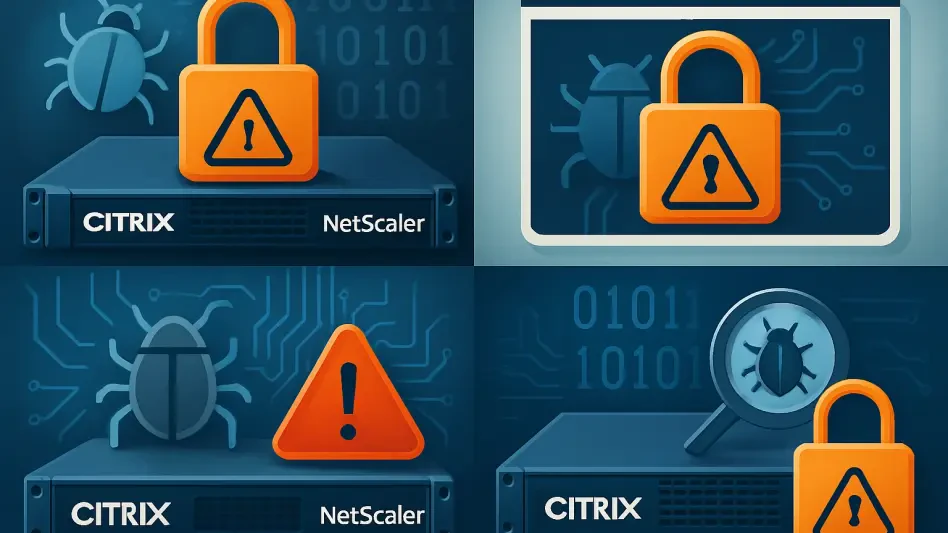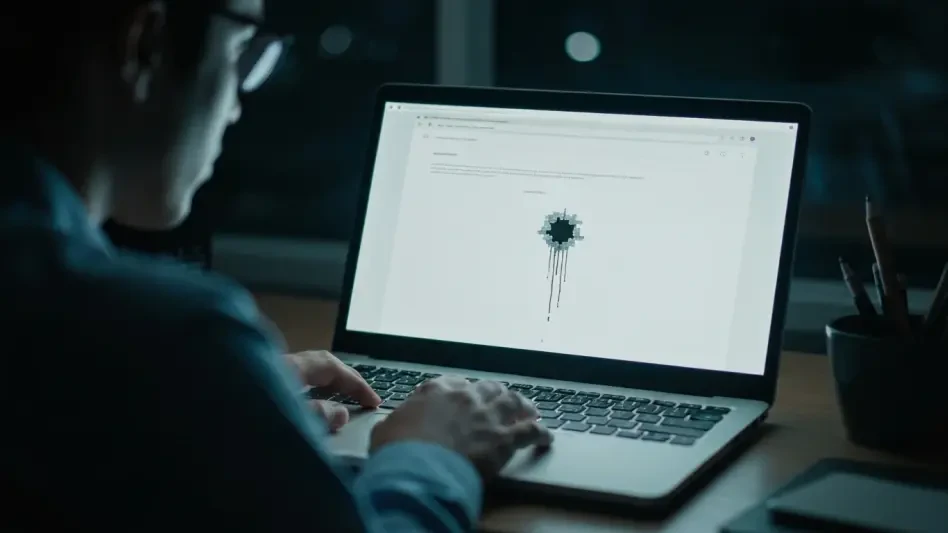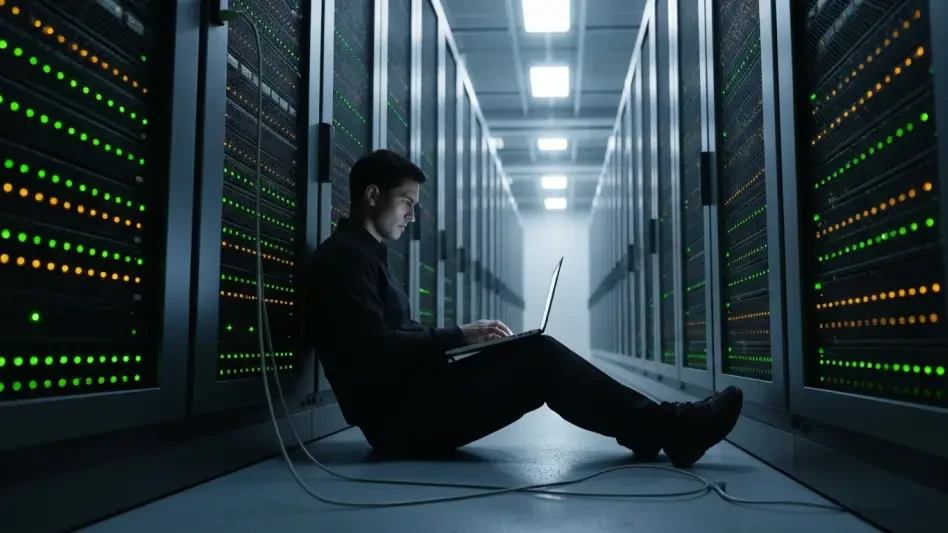In a deeply concerning turn of events for the cybersecurity landscape, Citrix, a prominent name in virtualization and networking solutions, has disclosed three critical zero-day vulnerabilities affecting its NetScaler ADC (Application Delivery Controller) and NetScaler Gateway products. Identified as CVE-2025-7775, CVE-2025-7776, and CVE-2025-8424, these flaws present severe risks due to their high potential for damage, with one already being actively exploited by malicious entities. The urgency of this situation cannot be overstated, as countless organizations worldwide depend on these systems to maintain secure and efficient network operations. With threat actors moving swiftly to take advantage of unpatched systems, the exposure of these vulnerabilities raises significant alarms about the readiness of businesses to counter such sophisticated attacks. This development serves as a stark reminder of the relentless pace of cyber threats and the critical importance of rapid response to safeguard sensitive infrastructure.
Urgent Threat Landscape
The gravity of these newly discovered vulnerabilities in Citrix NetScaler products is reflected in their high CVSS (Common Vulnerability Scoring System) scores, ranging between 8.7 and 9.2, which indicate a profound potential for disruption. CVE-2025-7775 and CVE-2025-7776 are classified as memory overflow flaws, enabling attackers to execute malicious code or cause system crashes with devastating consequences. Meanwhile, CVE-2025-8424 targets the NetScaler Management Interface, allowing unauthorized access to critical administrative controls. Most troubling is the active exploitation of CVE-2025-7775, referred to as “CitrixDeelb” by security researchers, which has been detected in real-world attacks even before patches became widely available. Internet scans have revealed a staggering number of unpatched appliances—tens of thousands globally—highlighting the extensive risk to organizations that have yet to address these flaws. This alarming reality underscores the immediate need for heightened vigilance and swift action to prevent widespread compromise.
Beyond the technical severity, the active exploitation of CVE-2025-7775 signals a dangerous trend in how quickly cybercriminals adapt to newly discovered vulnerabilities. The nickname “CitrixDeelb” reflects not only the flaw’s critical nature but also the attention it has garnered within the security community due to its exploitation in the wild. The sheer scale of vulnerable systems, as evidenced by independent scans showing thousands of exposed instances, paints a grim picture of global cybersecurity posture. Many organizations appear unprepared to respond to such threats, leaving sensitive data and critical operations at risk of being hijacked by attackers. The high CVSS ratings further amplify the concern, as they suggest that successful exploitation could lead to complete system takeovers or significant operational downtime. This situation serves as a wake-up call for businesses to reassess their vulnerability management strategies and prioritize rapid deployment of security measures to mitigate these pressing dangers.
Widespread Vulnerability Exposure
The scope of the Citrix NetScaler vulnerabilities extends across multiple versions of both ADC and Gateway products, affecting a broad array of systems, including on-premise and hybrid deployments used by organizations of all sizes. CVE-2025-7775 emerges as the most perilous of the trio, enabling pre-authentication remote code execution, which allows attackers to deploy backdoors or webshells without needing legitimate credentials. Such capabilities make it a prime tool for persistent access to compromised networks. Recent internet scans have uncovered a troubling statistic: approximately 84% of affected appliances remain unpatched, with over 28,000 instances specifically vulnerable to CVE-2025-7775 as of late August. This widespread exposure illustrates the daunting challenge facing IT teams tasked with securing these critical systems against an ever-evolving threat landscape, emphasizing the urgency of addressing these flaws before attackers can exploit them further.
Compounding the issue is the diverse range of environments impacted by these vulnerabilities, from small enterprises to large-scale government infrastructures that rely on NetScaler solutions for secure connectivity. The ability of CVE-2025-7775 to facilitate remote code execution without authentication represents a particularly insidious threat, as it lowers the barrier for attackers to infiltrate systems. The high percentage of unpatched systems suggests a lag in organizational response times, potentially due to resource constraints, lack of awareness, or complex update processes. With over 28,000 vulnerable instances identified, the window of opportunity for malicious actors remains dangerously wide open. This scenario highlights the critical need for automated vulnerability scanning and patch management systems to identify and remediate risks swiftly. Organizations must act decisively to close these gaps, as delays could result in severe breaches with far-reaching consequences for data integrity and operational continuity.
Immediate Patching Required
In response to the discovery of these critical zero-day flaws, Citrix took prompt action by releasing patches for all three vulnerabilities on August 26, urging customers to update to the latest supported versions without hesitation. The affected versions span a range of NetScaler ADC and Gateway releases, and the company has made it clear that no temporary workarounds exist to mitigate these risks—patching is the sole line of defense. Citrix has also noted that certain older versions, such as 12.1 and 13.0, are no longer supported, strongly advising users to upgrade to current releases to ensure ongoing security. This decisive guidance places significant responsibility on organizations to prioritize the update process and allocate resources effectively to protect their networks from potential exploitation by threat actors who are already targeting these vulnerabilities with alarming speed.
The absence of alternative mitigation strategies beyond patching adds a layer of urgency to Citrix’s advisory, as organizations cannot rely on stopgap measures to buy time. The company’s emphasis on upgrading to supported versions reflects a broader push for maintaining up-to-date systems as a fundamental aspect of cybersecurity hygiene. For many businesses, especially those operating on legacy versions, this may require significant planning and coordination to execute updates without disrupting critical services. Citrix’s proactive release of patches demonstrates a commitment to addressing the issue, yet the effectiveness of this response hinges on how quickly and thoroughly customers implement these fixes. Failure to act promptly could leave systems exposed to ongoing attacks, particularly given the active exploitation already observed. This situation reinforces the importance of having robust update mechanisms in place to respond to critical threats as soon as patches become available.
Beyond Patching: A Deeper Defense
Security experts across the industry have sounded the alarm that merely applying patches to address the Citrix NetScaler vulnerabilities falls short of a complete defense strategy. There is a strong consensus that organizations must go further by conducting thorough investigations to detect any signs of prior compromise, as attackers may have already exploited these flaws to establish a foothold within systems. The complexity of memory corruption flaws like CVE-2025-7775 and CVE-2025-7776 suggests that the adversaries leveraging them are likely sophisticated, possibly state-sponsored groups rather than opportunistic hackers. Such actors often leave behind persistent backdoors, making forensic analysis and system audits essential to ensure no malicious presence lingers. This multi-layered approach to security is crucial for mitigating not just the immediate threat but also the long-term risks posed by advanced persistent threats.
Additionally, there is growing concern among researchers about the potential for future attack campaigns that combine these vulnerabilities into devastating exploit chains. For instance, an initial breach using CVE-2025-7775 could be paired with CVE-2025-8424 to gain deeper access to management interfaces, effectively granting attackers full control over compromised systems. This possibility underscores the need for a holistic security posture that prioritizes both high-severity flaws and operationally critical weaknesses that might otherwise be overlooked. Experts advocate for continuous monitoring and threat hunting to identify unusual activity that could indicate an ongoing attack. By adopting such proactive measures, organizations can better safeguard their environments against the evolving tactics of cybercriminals. The insights from the security community highlight that defending against these threats requires more than technical fixes—it demands a cultural shift toward vigilance and preparedness in the face of increasingly sophisticated adversaries.
Strategic Steps Forward
Reflecting on the unfolding crisis surrounding the Citrix NetScaler zero-day vulnerabilities, it became evident that the active exploitation of CVE-2025-7775, alongside the high severity of the other flaws, posed an unprecedented challenge to global cybersecurity. Citrix’s rapid deployment of patches marked a critical first step, yet the vast number of unpatched systems revealed a persistent gap in organizational readiness. Expert analyses pointed to the sophistication of likely attackers and the necessity of in-depth investigations to uncover hidden breaches. As a path forward, organizations are encouraged to integrate automated patch management tools to streamline updates and minimize exposure windows. Additionally, investing in advanced threat detection systems can help identify and neutralize intrusions before they escalate. Collaboration with industry peers to share threat intelligence could further bolster defenses. Ultimately, this incident highlighted the need for a forward-thinking mindset, urging businesses to build resilient frameworks that anticipate and adapt to the relentless evolution of cyber threats.








